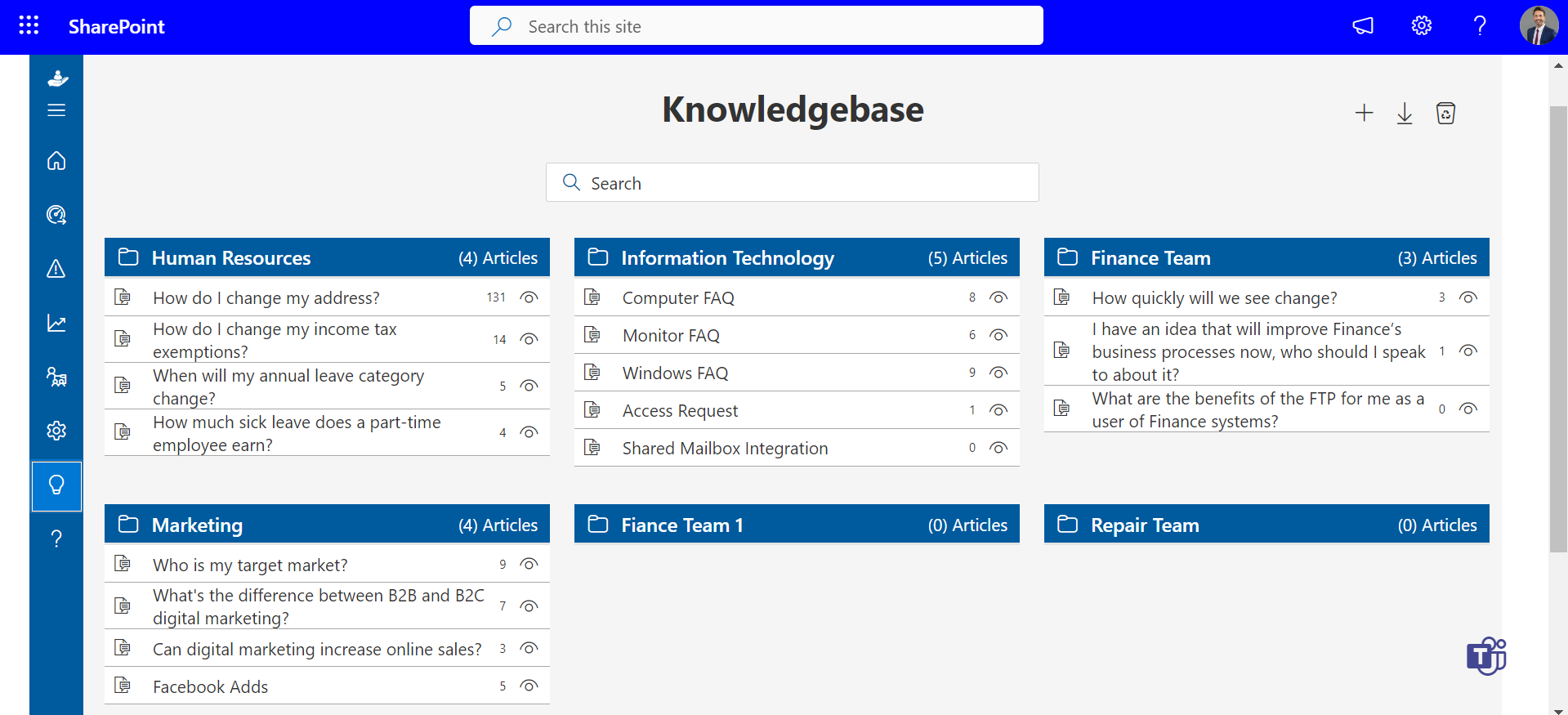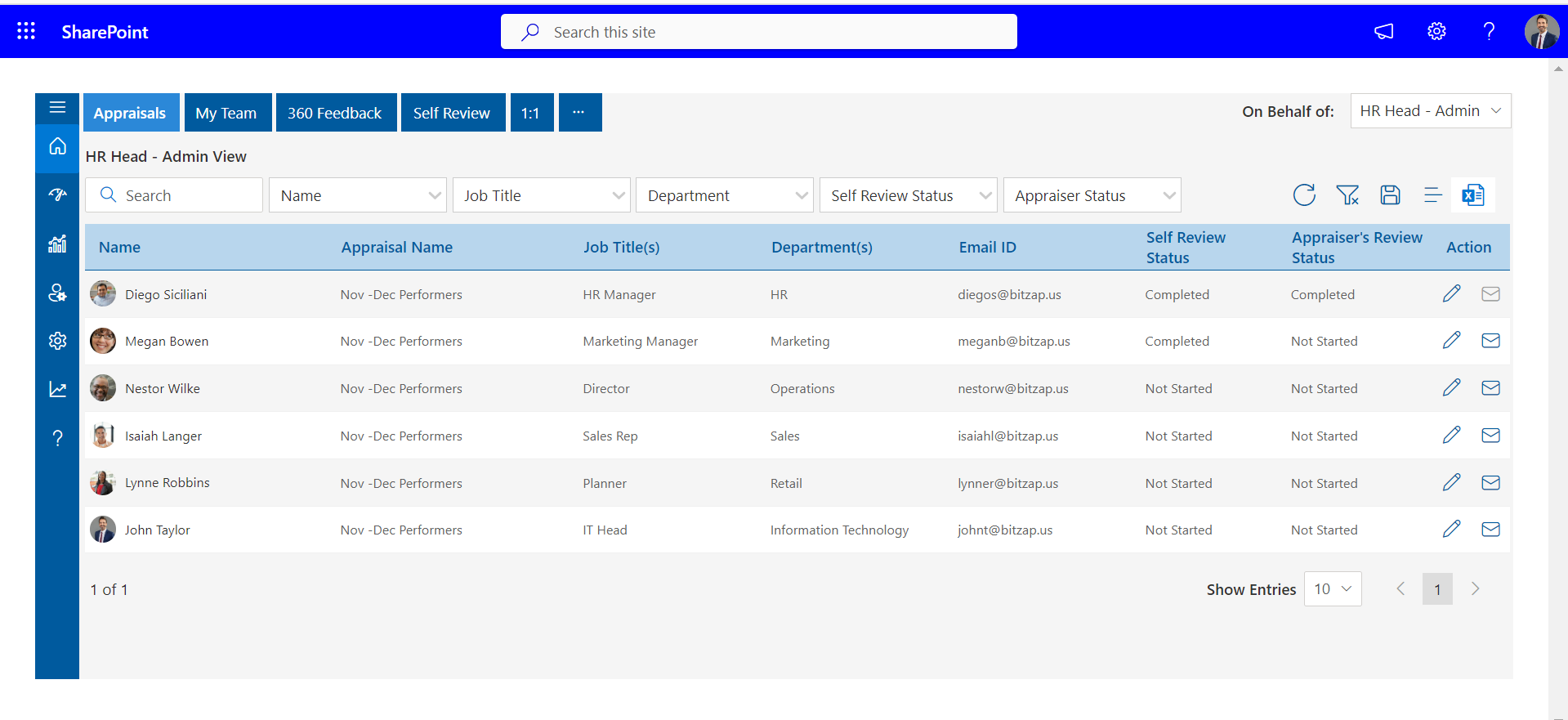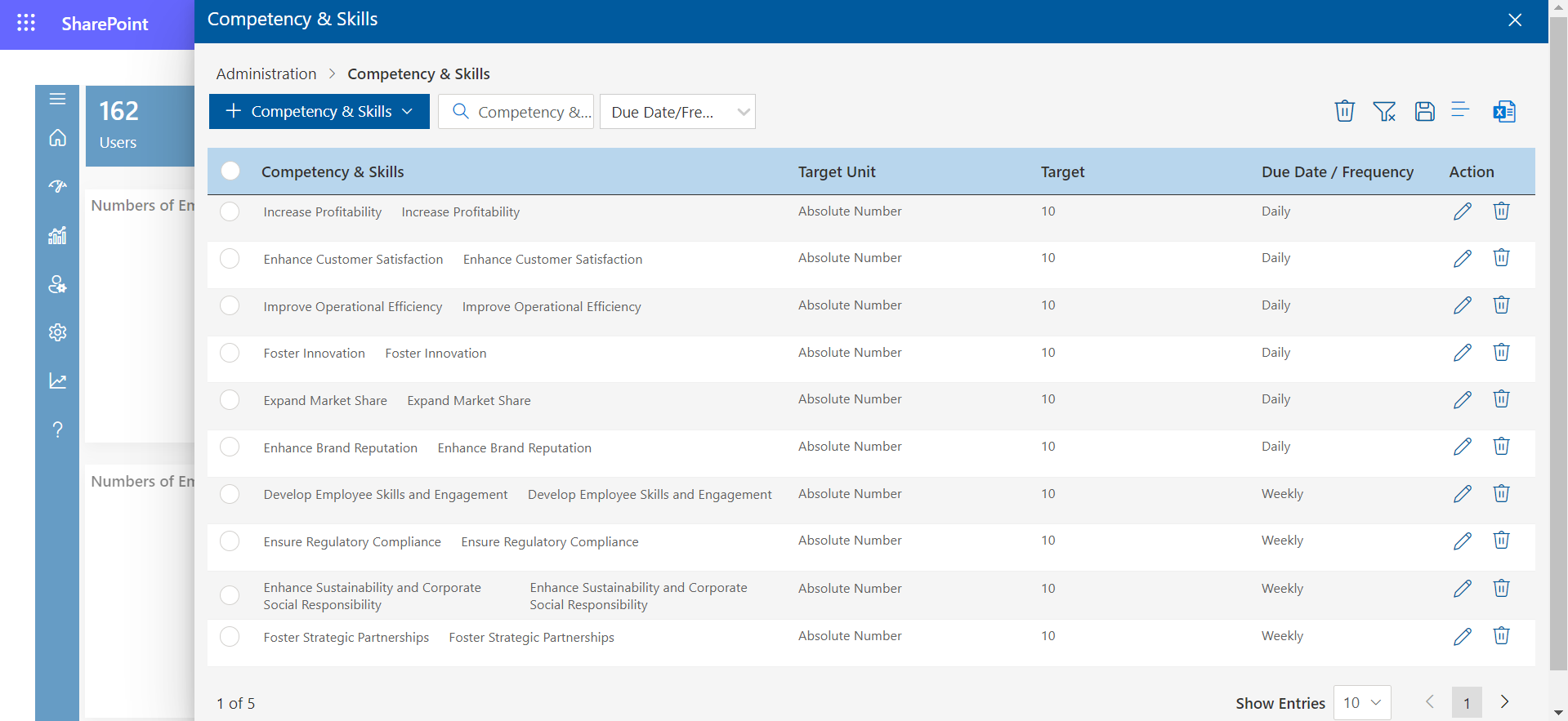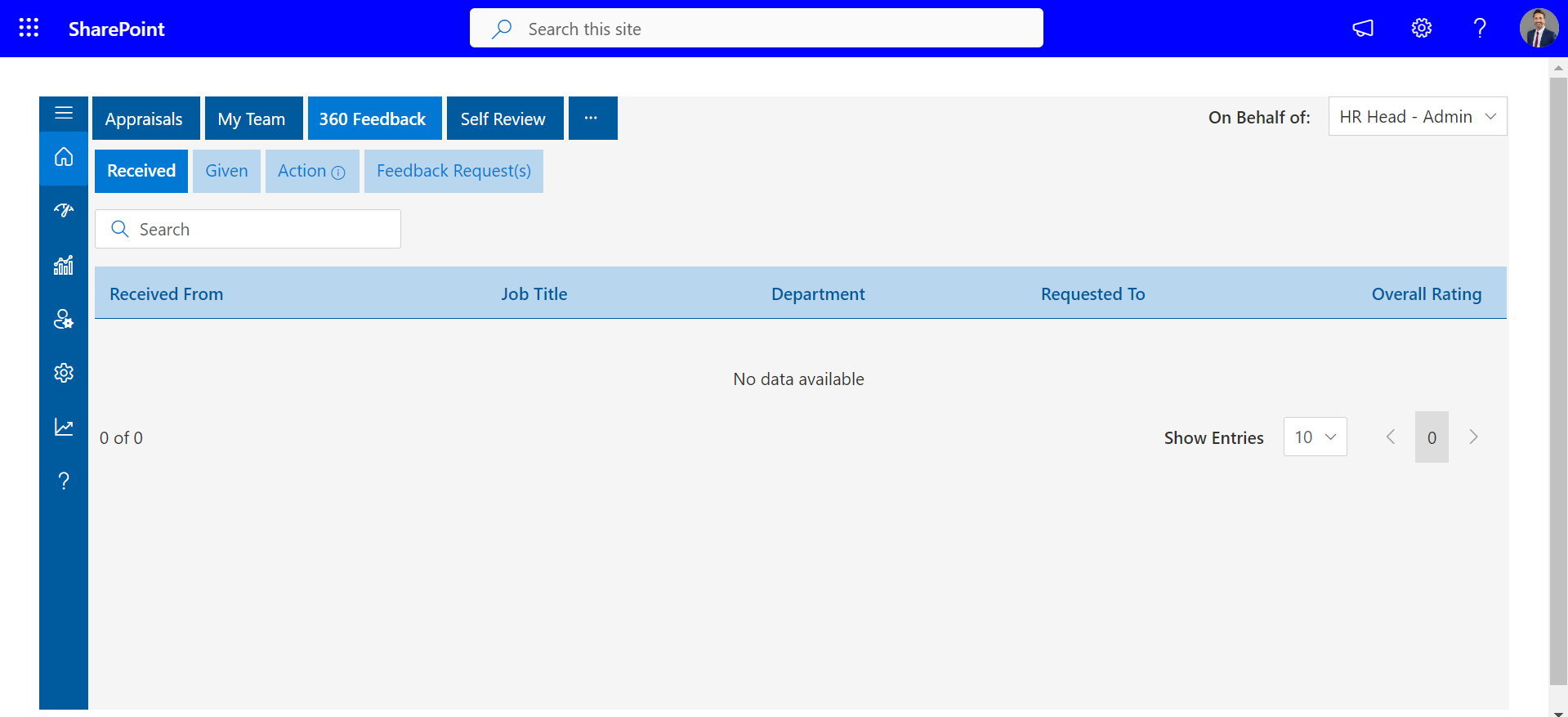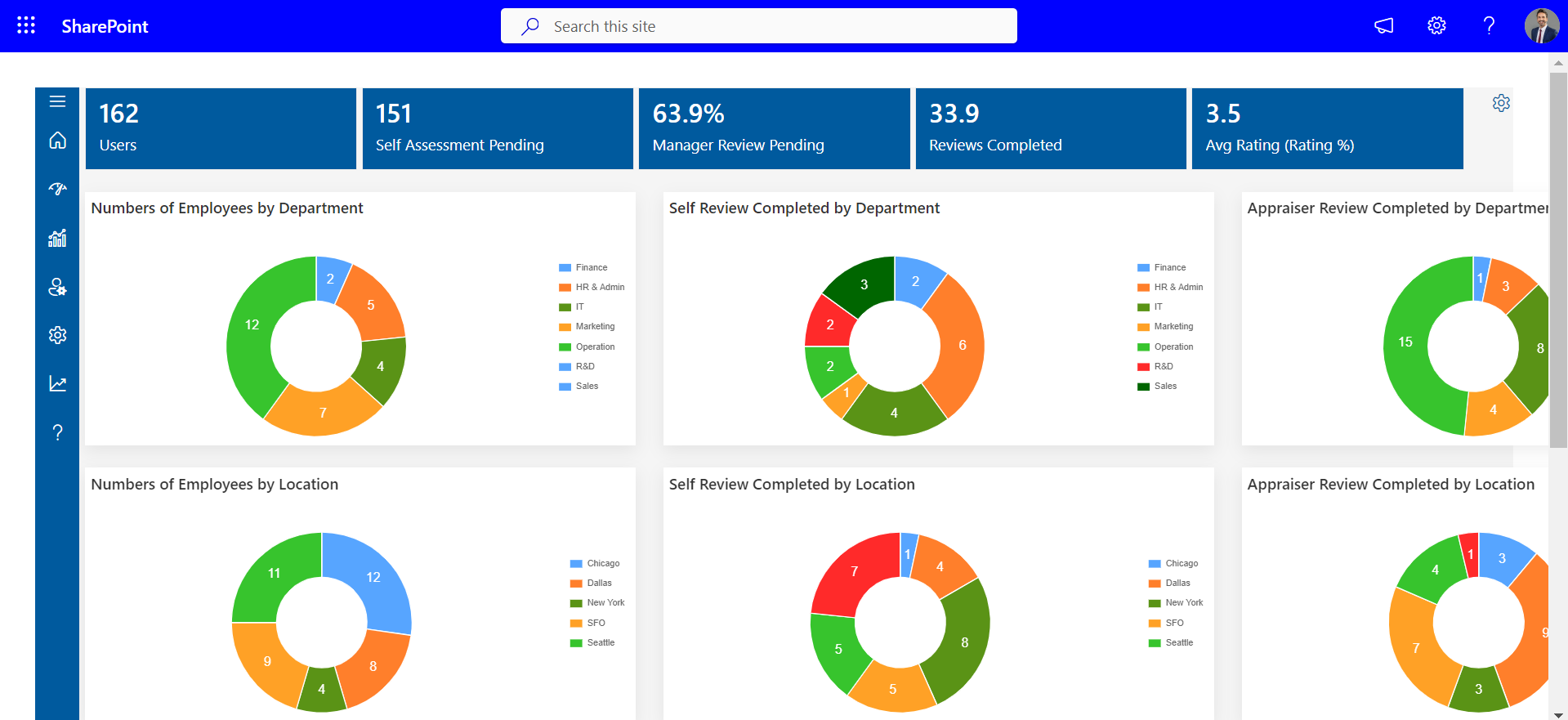Employee Performance Appraisal Software
Employee Performance Appraisal Software makes your employee evaluations easier which helps you in giving feedback and improve your team works.
Employee Performance Appraisal Software Complete Guide
Want to make performance reviews easier? Employee Performance Appraisal Software is the answer. No more confusing paperwork or complicated systems – we’ve got a simple solution that anyone can use. With options for feedback, tracking goals, and improving skills, your team will shine brighter than ever.
What is Employee Performance Appraisal Software?
Employee Performance Appraisal Software is a specialized kind of software designed with precision to make the process of assessing employee performance smoother and faster within companies and organizations. It acts as a central hub where managers and supervisors can carefully evaluate their employees’ work in a structured and effective manner. This software ensures that the evaluation process follows specific criteria, goals, and objectives set by the organization.
In essence, this software is like a dedicated assistant for managers, helping them streamline the task of assessing employee performance. It provides a platform where all necessary information and tools are readily available to conduct evaluations efficiently. By adhering to predefined standards and goals, it ensures consistency and fairness in the appraisal process.
What are the Core Functionality of Employee Performance Appraisal Software?
Performance appraisal tools typically include a range of core functionalities designed to streamline the performance evaluation process and provide valuable insights for both managers and employees. Here are some of the key functionalities commonly found in such software:
Goal Setting and Tracking:
Goal Setting and Tracking software facilitates the establishment of clear, measurable goals that are in line with organizational objectives. This tool empowers both managers and employees to collaboratively set targets and milestones, fostering alignment and clarity within the team. By providing a centralized platform, it enables seamless tracking of progress towards these goals over time, allowing for timely adjustments and interventions as necessary. This fosters accountability and transparency, driving improved performance and outcomes across the organization.
Workflow Automation:
Workflow Automation software optimizes the performance appraisal process by automating various tasks involved, including scheduling review meetings, sending timely reminders to both managers and employees, and consolidating feedback from multiple sources. By eliminating manual interventions and streamlining repetitive tasks, this tool enhances efficiency and reduces the likelihood of errors or oversights.
Additionally, it ensures consistency in the appraisal process across the organization, leading to fairer evaluations and more reliable insights into employee performance.
Integration with HR Systems:
Our integration capabilities streamline HR processes by seamlessly connecting with various systems, including payroll, talent management, and learning management platforms. By ensuring data consistency and process alignment across the organization, we optimize efficiency and accuracy in HR operations.
Whether it’s syncing employee information, managing training records, or facilitating payroll updates, our integrated approach enhances overall workflow cohesion. This integration not only saves time but also minimizes errors, fostering a more robust and synchronized HR ecosystem.
Compliance and Security:
Our platform prioritizes compliance with regulatory mandates and stringent data security standards, safeguarding sensitive employee information at every step. Through comprehensive encryption protocols, access controls, and regular audits, we maintain the integrity and confidentiality of all data.
By staying abreast of evolving regulations and industry best practices, we ensure that our system adapts to changing compliance landscapes seamlessly. This commitment to compliance and security instils trust among users, reassuring them that their data is handled with the utmost care and protection.
360-Degree Feedback:
Our 360-degree feedback system enables employees to receive insights on their performance from diverse sources, including peers, subordinates, and managers. By gathering feedback from multiple perspectives, it offers a holistic view of an individual’s strengths, areas for improvement, and overall impact within the organization.
This approach fosters a culture of transparency, collaboration, and continuous development, as employees gain valuable insights into how their actions resonate across different levels of the organization.
Continuous Feedback and Coaching:
Our system facilitates continuous feedback and coaching dialogues between managers and employees, transcending traditional annual reviews. By enabling ongoing conversations throughout the year, it cultivates a culture of continuous improvement and development.
Managers can provide timely guidance, address performance issues promptly, and recognize achievements in real-time, enhancing employee engagement and motivation. This approach fosters a dynamic feedback loop, empowering employees to adapt, grow, and excel in their roles. With regular communication and support, individuals can proactively address challenges and maximize their potential, contributing to organizational success.
Performance review
Performance review functionality in employee appraisal software enables organizations to effectively manage the entire review process. It empowers managers to schedule reviews, complete assessments, and document performance discussions within a centralized platform. The software offers customizable review templates tailored to specific job roles or performance criteria, ensuring consistency and relevance.
Managers can track the progress of reviews, monitor completion status, and set reminders for pending assessments. Additionally, the system facilitates constructive feedback exchange between managers and employees, fostering continuous improvement and alignment with organizational goals.
Who Can Use Employee Performance Appraisal Software?
Staff appraisal software can be utilized by various stakeholders within an organization, including:
Managers and Supervisors: Managers and supervisors often play a central role in conducting performance evaluations. They use the software to schedule, conduct, and document performance reviews for their team members. Additionally, they rely on the software to track progress, provide feedback, and set goals for employee development.
Human Resources (HR) Professionals: HR professionals are typically responsible for overseeing the performance management process across the organization. They use performance appraisal software to ensure compliance with company policies and procedures, manage administrative tasks related to performance reviews, generate reports for analysis, and provide support and training to managers and employees.
Employees: Employees themselves can benefit from performance appraisal software by actively participating in the review process. They use the software to access self-assessment forms, set goals, document achievements, and provide feedback to their managers. This fosters transparency, accountability, and employee engagement in their own performance management.
Executives and Decision-makers: Executives and senior leaders within the organization may utilize performance appraisal software to gain insights into overall workforce performance, identify talent gaps, and make strategic decisions related to talent management and succession planning. They rely on the data and analytics provided by the software to inform organizational strategies and initiatives.
Training and Development Teams: Training and development professionals can leverage performance appraisal software to identify skill gaps and training needs among employees. They use the data collected through performance evaluations to design and deliver targeted training programs aimed at improving individual and team performance.
Consultants and External Auditors: External consultants or auditors may also use performance appraisal software to assess the effectiveness of an organization’s performance management processes. They may review the software’s functionalities, data accuracy, and alignment with best practices to provide recommendations for improvement.
What are the Importance of Employee Performance Appraisal Software?
HR appraisal software plays a crucial role in modern organizations by streamlining and enhancing the performance evaluation process. Its importance stems from several key aspects:
- Efficiency: Performance appraisal software automates many aspects of the appraisal process, saving time for both managers and employees. It eliminates manual paperwork, data entry, and administrative tasks associated with traditional performance evaluations.
- Accuracy: By digitizing the performance evaluation process, software reduces the likelihood of errors in data entry and calculation. It ensures that performance ratings and feedback are based on objective criteria and consistent standards, enhancing the fairness and reliability of the appraisal process.
- Transparency: Performance appraisal software provides a transparent platform for documenting and tracking performance metrics, goals, and feedback. Employees can access their performance data and understand how their contributions align with organizational objectives, fostering accountability and engagement.
- Feedback and Coaching: Many performance appraisal software platforms include features for providing continuous feedback and coaching. Managers can easily schedule one-on-one meetings, set development goals, and provide timely feedback to employees, facilitating ongoing performance improvement and professional development.
- Data-driven Insights: Performance appraisal software generates valuable insights and analytics from performance data, enabling organizations to identify trends, strengths, and areas for improvement across teams and departments. These insights inform strategic decision-making related to talent management, succession planning, and resource allocation.
- Alignment with Organizational Goals: Performance appraisal software allows organizations to align individual performance goals with broader organizational objectives. By cascading goals and objectives throughout the organization, software ensures that employee efforts are focused on activities that drive business results and support strategic priorities.
- Compliance and Legal Requirements: SharePoint performance management software helps organizations maintain compliance with legal requirements and industry standards for performance management. It enables consistent application of performance evaluation criteria and documentation of performance-related discussions, reducing the risk of legal disputes or regulatory non-compliance.
Challenges of Employee Performance Appraisal Software?
While employee performance appraisal software offers numerous benefits, it also presents several challenges that organizations may encounter:
1)Implementation Complexity: Implementing performance appraisal software can be complex, requiring careful planning, customization, and integration with existing HR systems. Organizations may face challenges in configuring the software to align with their unique performance management processes and organizational structure.
2)User Adoption: Resistance to change and lack of user buy-in can hinder the successful adoption of performance appraisal software. Employees and managers may be reluctant to embrace new technology or perceive the software as an additional administrative burden, leading to low utilization and ineffective performance management practices.
3)Training Needs: Employees and managers may require training to effectively use performance appraisal software and understand its features and functionalities. Inadequate training can result in user errors, data inaccuracies, and underutilization of the software’s capabilities, undermining the effectiveness of the performance management process.
4)Data Security and Privacy Concerns: Performance appraisal software involves the collection and storage of sensitive employee data, raising concerns about data security and privacy. Organizations must implement robust security measures to protect employee information from unauthorized access, data breaches, and compliance violations.
5)Bias and Fairness: Despite efforts to standardize performance evaluation criteria, performance appraisal software may still be susceptible to biases and subjectivity in the evaluation process. Biases related to gender, race, age, or other factors can inadvertently influence performance ratings and feedback, leading to perceptions of unfairness and undermining employee morale and engagement.
6)Technical Issues: Performance appraisal software may experience technical glitches, downtime, or compatibility issues with other systems, disrupting the performance management process and causing frustration among users. Organizations must have contingency plans in place to address technical issues promptly and minimize their impact on performance evaluations.
7)Customization Limitations: While performance appraisal software offers configurable features and templates, organizations may encounter limitations in customizing the software to meet their specific needs and requirements. Lack of flexibility in the software’s design may prevent organizations from fully aligning Microsoft performance management practices with their unique organizational culture and objectives.
How Employee Performance Appraisal Software evolved?
Employee Performance Appraisal Software has evolved significantly over the years, adapting to changes in technology, work culture, and organizational needs. Here’s an overview of how it has evolved:
1)Manual Systems (Paper-Based):
- Historically, performance appraisals were conducted manually using paper-based forms and documents.
- This process was time-consuming, prone to errors, and lacked efficiency.
2)Early Digital Solutions:
- The advent of computers led to the development of digital solutions for performance appraisals.
- Basic software allowed for the digitization of appraisal forms and data storage.
3)Customized Software Solutions:
- Organizations began developing customized software solutions tailored to their specific performance management processes.
- These solutions often integrated with other HR systems for better data management and analysis.
4)Introduction of Cloud-Based Platforms:
- Cloud computing revolutionized performance appraisal software by offering accessibility from anywhere with an internet connection.
- Cloud-based platforms allowed for real-time collaboration, feedback, and tracking of employee performance.
5)Focus on Continuous Feedback:
- Modern performance appraisal software shifted focus from annual or periodic reviews to continuous feedback and coaching.
- Features such as real-time feedback, goal tracking, and performance journals became common.
6)Integration with HRIS and Talent Management Suites:
- Integration with broader Human Resource Information Systems (HRIS) and Talent Management Suites became prevalent.
- This integration allowed for seamless data flow between different HR functions such as recruitment, training, and performance management.
7)Emphasis on Data Analytics and AI:
- Advanced analytics capabilities and Artificial Intelligence (AI) tools were incorporated into performance appraisal software.
- Predictive analytics helped in identifying trends and patterns in employee performance data.
- AI-driven insights provided personalized recommendations for employee development and career pathing.
8)Mobile Accessibility:
- Mobile applications became common, allowing employees and managers to access performance appraisal tools on-the-go.
- Mobile accessibility enhanced the flexibility and convenience of performance management processes.
Conclusion:
In conclusion, employee performance appraisal software has come a long way, evolving alongside technological advancements, and shifting workplace dynamics., modern performance appraisal tools offer accessibility and diverse features tailored to meet organizational needs, the best performance appraisal software seamlessly integrates user-friendly interfaces with powerful analytics to enhance both employee engagement and organizational growth. Experience our top-class performance management 365 and step confidently into a more organized future.
Frequently Asked Questions
Top performance appraisal software providers prioritize data security and compliance with data protection regulations such as GDPR (General Data Protection Regulation) and CCPA (California Consumer Privacy Act). Look for software vendors that offer robust security measures such as encryption, access controls, and regular security audits.
Yes, many performance appraisal software solutions offer customization options to adapt to different organizational structures, workflows, and performance management frameworks. You can typically customize evaluation criteria, review templates, and workflows to align with your organization’s unique requirements.
The ease of implementation depends on the complexity of the software and the readiness of your organization. Cloud-based solutions often have faster implementation timelines since they require minimal IT infrastructure. Additionally, many software providers offer implementation support, training resources, and customer success teams to assist organizations throughout the process.
Most of above if not all, can be addressed by out of the box, secured, easy to use and reliable Performance Management software by Performance Management 365 from HR365 built on Microsoft 365 platform and used globally by 6000+ clients.
Performance appraisal software offers several benefits, including:
- Streamlined process: Automates tasks, reduces paperwork, and saves time.
- Improved accuracy: Provides standardized evaluation criteria and reduces human error.
- Enhanced transparency: Allows for clear communication of goals, expectations, and feedback.
- Data-driven insights: Enables analysis of performance trends and identification of areas for improvement.
- Employee engagement: Facilitates regular feedback and encourages continuous development.
Performance appraisal software can support employee development by:
- Identifying strengths and areas for improvement through regular feedback and assessments.
- Setting clear and actionable goals aligned with individual and organizational objectives.
- Providing access to training resources, learning opportunities, and skill development initiatives.
- Tracking progress over time and recognizing achievements to motivate employees.
Reputable performance appraisal software providers adhere to strict security protocols to protect sensitive employee data. This often includes encryption, access controls, regular audits, and compliance with data protection regulations such as GDPR or CCPA. It’s essential to choose a trusted vendor with robust security measures in place.
Yes, many performance appraisal software solutions offer customization options to align with your organization’s unique goals, values, and evaluation criteria. You can often tailor evaluation forms, rating scales, and reporting formats to suit your specific requirements.
Schedule a free personalized 1:1 demo
By proceeding, you accept Cubic Logics’s terms and conditions and privacy policy






Start Your Free Experience
By proceeding, you accept Cubic Logics’s terms and conditions and privacy policy






Schedule a free personalized 1:1 demo
By proceeding, you accept Cubic Logics’s terms and conditions and privacy policy






Try It Free, No Obligation
By proceeding, you accept Cubic Logics’s terms and conditions and privacy policy






Request of the Free License
By proceeding, you accept Cubic Logics Terms and Conditions and Privacy Policy
Offer is expiring soon!
Fill in your details below to receive your personalized coupon code.
Start Your Free Experience
By proceeding, you accept Cubic Logics’s terms and conditions and privacy policy








